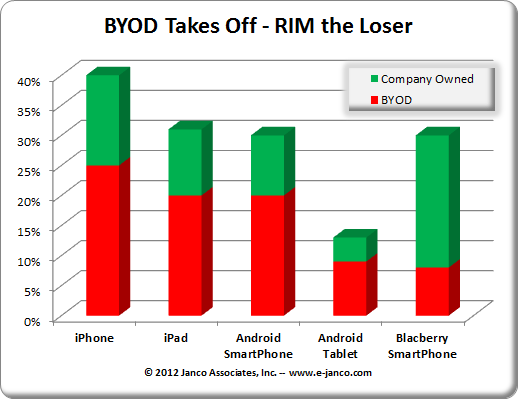BYOD driven by HTML5 takes off and drives the move away from RIM
Apple and Android take over as the devices of choice over Blackberry
BYOD driven by HTML5 takes off and drives the move away from RIM - Unlike RIM Blackberry SmartPhone - the traditional mainstay among corporate SmartPhone users - personally owned Apple iPhone and iPads, as well as Android SmartPhone and tablets, are more common than their company-supplied counterparts. With companies controlling costs RIM is the big loser as more companies allow Bring-Your-Own-Device (BYOD) to access corporate data.
RIM has lost the application war and is not well suite for the HTML5 revolution. Consumers are calling the shots when it comes to choosing end devices, and guess what? They want one phone or tablet, and it's not a Blackberry.

Ironically, RIM, with its enterprise roots, is poorly equipped to compete with a consumerization trend that has put end users in charge. BYOD has broken the one-size-fits-all model of Black Berry and opened up more flexibility,"says one analyst from a major research firm.
Read on BYOD Policy Order BYOD Policy Download Selected Pages
Organizations are now adopting a “mobile first” mind-set and taking advantage of HTML5 will be the ones to maintain their competitive advantage and succeed in today's increasingly mobile-savvy market. Additionally, with widespread 3rd party forecasts that Business-to-Employee deployments will take off this year as organizations make mobile a more strategic part of their IT infrastructure. Five key mobile market trends companies should prepare for now include:
- Rise of Mixed Mode Apps -- Not all apps are created equal. To take advantage of the benefits of HTML5, along with the ever-expanding capabilities of mobile devices, organizations will rely on mixed mode apps that combine HTML5 features like enhanced animations and transitions, along with the performance-oriented abilities of native apps to achieve the best individual user experience across , tablets, kiosks and desktops.
- HTML5 Pushes the Boundaries of Handset Capabilities -- There are more than 9,000 mobile devices on the market and new devices are entering the market at a ferocious pace. Predictions include 44 billion applications will be downloaded by 2016--it's clear consumers are expecting to have a high-quality and feature-rich applications for just about everything. Even though HTML5 isn't expected to be ratified until 2017, support for this evolving standard is on everyone's road map, and developrs and IT departments are hustling to incorporate this functionality to meet consumer demand.
- Application developrs Tackle HTML5 Using Prior Expertise -- Embracing HTML5 does not mean organizations must start from scratch to implement optimized mobile solutions. Tapping existing Java Script knowledge, organizations will leverage their current resources when integrating HTML5 technology, thus redefining the developr's job description.
- The Mobile Workforce -- HTML5 And BYOD Come Together --In the age of the mobile workforce, today's employees bring their own devices to work and expect more than a cookie-cutter enterprise applications . Organizations will be hard-pressed to find an executive who does not expect feature-rich data, location awareness, and visualization tools when surveying company analytics on-the-go via their mobile devices. And as more organizations implement B2E mobile solutions, we will increasingly see HTML5 as a key enabler of these offerings.
- Organizations Restructure To Adapt -- As BYOD evolves, organizations are restructuring the roles of IT departments. This change will manifest itself in the role of a Mobile czar charged with assigning application policies, regulating internal practices and ensuring solutions are optimized to take full advantage of the mobile channel. No longer will teams look first to the Web Development department - instead, expect mobile to lead the charge on business strategy.


